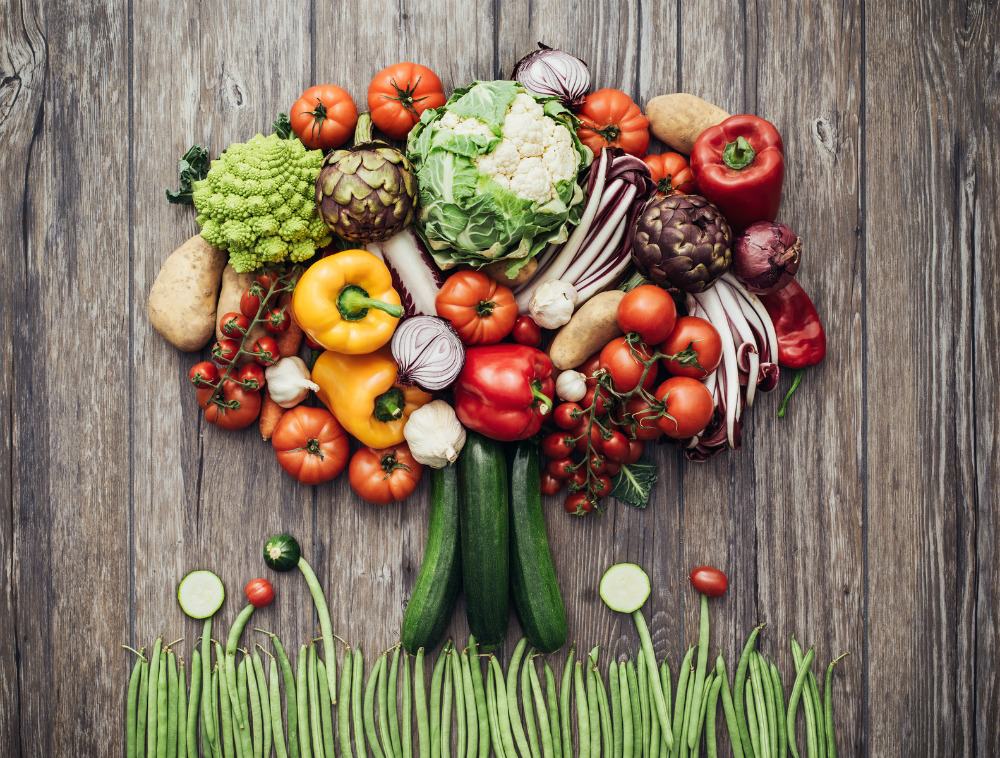Table of Contents[Hide][Show]
- Step 1: Say NO to processed, refined, and artificial foods
- Step 2: Eliminate The White Stuff, yes I mean refined/processed sugar
- Step 3: Here’s an easy step–use sea salt
- Step 4: Check out your farmer’s market
- Step 5: Eat more butter, fats, and oils
- Step 6: Your new GO TO food: homemade bone broth
- Step 7: McFast Foods
- About the Author
 Do you want to eat more nourishing foods? Have you heard about the value of traditional foods and their preparation?
Do you want to eat more nourishing foods? Have you heard about the value of traditional foods and their preparation?
Maybe you’ve heard Sally Fallon Morell speak or you’ve read Nourishing Traditions. Has this blog,The Healthy Home Economist, piqued your interest, and are you ready to take the plunge?
Where to begin?? Not to worry. I will help you get started with some straightforward “baby” steps–and you can even decide which step will be your first. It’s your decision. Here we go.
Step 1: Say NO to processed, refined, and artificial foods
Start reading those labels, especially the list of ingredients. Consider this: what kinds of processing have been done to the product you want to buy in order to get it into the form it is in now? Do you still want it? Your goal is to eliminate additives, artificial sweeteners, etc., as much as possible. A great way to make shopping easy is to take your WAPF Yearly Shopping Guide with you.
Step 2: Eliminate The White Stuff, yes I mean refined/processed sugar
We are addicted to this tasty poison. Think of this step as a food adventure into local raw honey, pure maple syrup, and other natural sweeteners like coconut, dates, and carrots. Lots of great recipes use natural sweeteners.
Time to get off refined sugar for good!
How about considering fruit as your new dessert? A baked spiced apple with a big dollop of homemade créme fraiche sounds pretty yummy, right? And, yes, there are really good sweets with no high fructose corn syrup or artificial sweeteners.
Step 3: Here’s an easy step–use sea salt
You get more minerals by eating unrefined salts from the sea or salt flats. Color is good–even pink, black, or gray. Bright white usually indicates a no no because it is refined and processed. Avoid iodized salt and MSG as much as possible.
You’ve already taken three easy steps. Good for you!
Step 4: Check out your farmer’s market
This is a great way for your family and friends to join in your new lifestyle. The Local Harvest website makes it very easy to find fresh and sustainably grown produce. Don’t be afraid to ask questions of the vendors. You can also join a CSA (community-supported agriculture) group.
If you don’t have a farmer’s market nearby, choose the pesticide-free or organic produce or buy dried or frozen organic fruits and vegetables. Remember to read those labels! If you are concerned about cost, use the Environmental Working Group’s Dirty Dozen and its Clean 15 List to determine your “must avoids” and alternatives.
Step 5: Eat more butter, fats, and oils
Say hello to butter and goodbye to canola. If you are used to low-fat foods, you’ll want to add good fats back into your diet slowly–or work with a nutritional therapy practitioner. Start converting your favorite recipes to good fats like unrefined extra virgin coconut oil, raw pastured butter, or unrefined extra virgin olive oil.
Step 6: Your new GO TO food: homemade bone broth
This is a must. It also tastes better than store bought, and it’s a financial win win. After you roast a chicken, use the bones to make broth. Work toward having a supply of broth in your freezer.
Here’s a great recipe for beef stock to try. Not only is broth comforting when you’re sick or tired, but it is also a great base for many quick meals, soups, one-pot dinners, gravies, and sautéing. Not ready to take this step? Then make sure your store-bought stock has no additives or MSG.
Step 7: McFast Foods
We all get the munchies some time. To help make better food choices, have on hand fast and easy foods that you or your small ones can grab and go: hard-boiled eggs, carrot/celery sticks, homemade trail mix, hummus, yogurt, cheese, and fermented veggies.
If you know you’re not going to have time to make dinner, set up a slow cooker in the morning for one-pot meals like soup, beans, stew, and meats. In fact, try Nourishing Days’ sprouted lentil soup or Kelly the Kitchen Kop’s beef stroganoff.
The key to your transition it to take it slowly–just one step at a time. Yes, it might take a little time but–before you know it–you will have taken major steps to a more traditional foods way of life with a smile on your face, money in your pocket, and a healthier YOU!
Congratulations–you’ve brought it home! For more steps and other tips, go to Traditional Foods Coach and sign up to receive your one-page guide: Steps to a Traditional Foods Way of Life.
About the Author
 Jennifer McManamee is a Traditional Foods Coach and the Chicago Chapter Leader for the Weston A. Price Foundation.
Jennifer McManamee is a Traditional Foods Coach and the Chicago Chapter Leader for the Weston A. Price Foundation.
Be sure to visit her website to sign up to receive your free one page guide for Steps to a Traditional Foods Way of Life.








I agree with everything you have written. But I am LOLing at the thought of most of America’s almost certain reaction to your suggestion to eat fermented vegetables instead of McFast Food!
This is awsome, thanks for includin all the recipes, traditional cooking takes so much time, so my poor family just eats soup everynight for dinner.. my husdand is getting sick of it. It will good to try something new.
Oh and don’t forget to have sweets on hand!!!! I always have macaroons or almond flour muffins in the fridge so when I’m craving something yummy I don’t run out and grab a milk shake.
can’t wait to share this on FB
Why do you need to introduce good fats slowly? Have recently recommended to a friend she needs to swap processed carbs for fat, is this bad advice?
Suddenly adding a lot of fat to your diet can lead to interesting bowel movements…
The process probably doesn’t need to take very long – add a Tbsp of coconut oil for three days, then put some olive oil on your salad for a few more days, and so on.
Rather than suggesting swapping processed carbs for fat, I would encourage adding good fats and reducing processed carbs.
Many have GI upset when increasing fats following a period of low fat foods. It can include bowel changes but also stomach aches and cramping. Starting with coconut and olive oil is a great suggestion. Of course a little butter never hurts either!
Fantastic! These are great basic steps that anyone can follow. Don’t forget your raw milk and cod liver oil!!
I love this and shared it on my wall. Very inspiring. My family is working in stages, too. It’s OK to transition slowly, I think, just don’t lose sight of the goal!
You are correct – keeping sight of the goal. Good for you! I say baby steps are better than no steps.
Great tips. I like the simplicity but also prioritizing other nutritional tips like bone broth, soaking, fermenting, etc. Seems like most post talk about eating more fruits & veggies and stop refined foods but do not go to the next level (ie changing fats) This is a grat start for those like myself who just read Nourishing Traditions and want to take our nutrition to the next level without getting overwhelmed and burned out. based on what this site talks about I’m surprised raw milk was not on the list. Hopefully a follow up article would talk about next steps after you made these switches (ie milk, soaking, fermenting, supplement like fish oils). Thanks!
The seven steps are meant to be the starting point of transitioning to a more traditional diet of nutrient dense whole foods. Great next steps are: incorporating a good fermented cod liver oil; soaking nuts, grains and seeds; meats, dairy and eggs from grass-fed animals; and of course fermented or cultured veggies, fruits and such. Go to the Traditional Foods Coach website and sign up to receive your one-page guide: Steps to a Traditional Foods Way of Life for the complete ‘getting started’ list..
It’s been a few years in the making .. transitioning .. and the health benefits are great! Feed your (nutritionally) starving body the good stuff .. and reap the rewards 🙂
I’m looking forward to changing.
Great article! I have been changing my family’s diet over the past couple of months, taking small steps to eating real food. This list simplifies things and encourages me.
What do you think about the use of expeller pressed coconut oil? I would like an oil that doesn’t have a flavor to use in things like homemade nut butters. Ideas?
Thank you!
I like the Centrifuged Organic Virgin Coconut Oil from Wilderness Family Naturals when I am wanting less of the coconut flavor. It is expeller pressed from fresh coconuts.